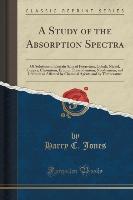- Start
- A Study of the Absorption Spectra
A Study of the Absorption Spectra
Angebote / Angebote:
Excerpt from A Study of the Absorption Spectra: Of Solutions of Certain Salts of Potassium, Cobalt, Nickel, Copper, Chromium, Erbium, Praseodymium, Neodymium, and Uranium as Affected by Chemical Agents and by Temperature
This investigation on the absorption spectra of solutions is a continuation of the work of Jones and Uhler and Jones and Anderson, and has been made possible by grants generously awarded by the Carnegie Institution of Washington. The results obtained from the study of about 3000 solutions are recorded in this monograph. These include salts of potassium with a colored anion, cobalt, nickel, copper, chromium, erbium, praseodymium, neodymium, and uranyl and uranous uranium.
The effect of the addition of free acids and foreign salts on the absorption spectra is studied at some length and in considerable detail, and results have been obtained which show that chemical reactions in general are probably much more complex than is represented by the equations which are usually employed to express such chemical changes.
The effect of the nature of the solvents on the absorption spectra of substances dissolved in those solvents has been one of the chief points investigated in this work. It is shown that solvents which themselves do not absorb visible light may have a determining influence on the absorption of the dissolved substances. Well-defined "solvent-bands" have been discovered for water, the alcohols, acetone, and glycerol. These bands are perfectly characteristic of each solvent, and their existence is regarded as strong evidence for the theory of solvation, upon which work has been in progress in this laboratory for the past 12 years.
It is difficult to see how the solvent can affect so markedly the resonance of the vibrators unless it forms some kind of a compound or system with the dissolved substance. Indeed, I am inclined to regard this evidence from the absorption spectra of solutions, for the general correctness of the solvate theory of solutions, as being so strong and unambiguous that there scarcely remains a reasonable doubt that dissolved molecules and especially ions combine with more or less of the solvent. This is especially true when we take into account the various other lines of evidence, all of which point to the same conclusion.
A large amount of work has been done on the effect of temperature on the absorption spectra of aqueous solutions, and the results are here recorded. A special form of apparatus was designed by Dr. Anderson for this work, involving the principle of total reflection from quartz prisms, which was found to work admirably. These prisms being movable in a glass trough containing the solutions, allowed different lengths of the solutions, and, consequently, very different concentrations, to be interposed into the path of the beam of light.
A piece of pressure apparatus with thick steel walls and quartz and glass ends has been devised for work with aqueous and nonaqueous solutions at high temperatures, and we are now studying the absorption spectra of such solutions at high temperatures.
About the Publisher
Forgotten Books publishes hundreds of thousands of rare and classic books. Find more at www.forgottenbooks.com
This book is a reproduction of an important historical work. Forgotten Books uses state-of-the-art technology to digitally reconstruct the work, preserving the original format whilst repairing imperfections present in the aged copy. In rare cases, an imperfection in the original, such as a blemish or missing page, may be replicated in our edition. We do, however, repair the vast majority of imperfections successfully, any imperfections that remain are intentionally left to preserve the state of such historical works.
Folgt in ca. 5 Arbeitstagen

